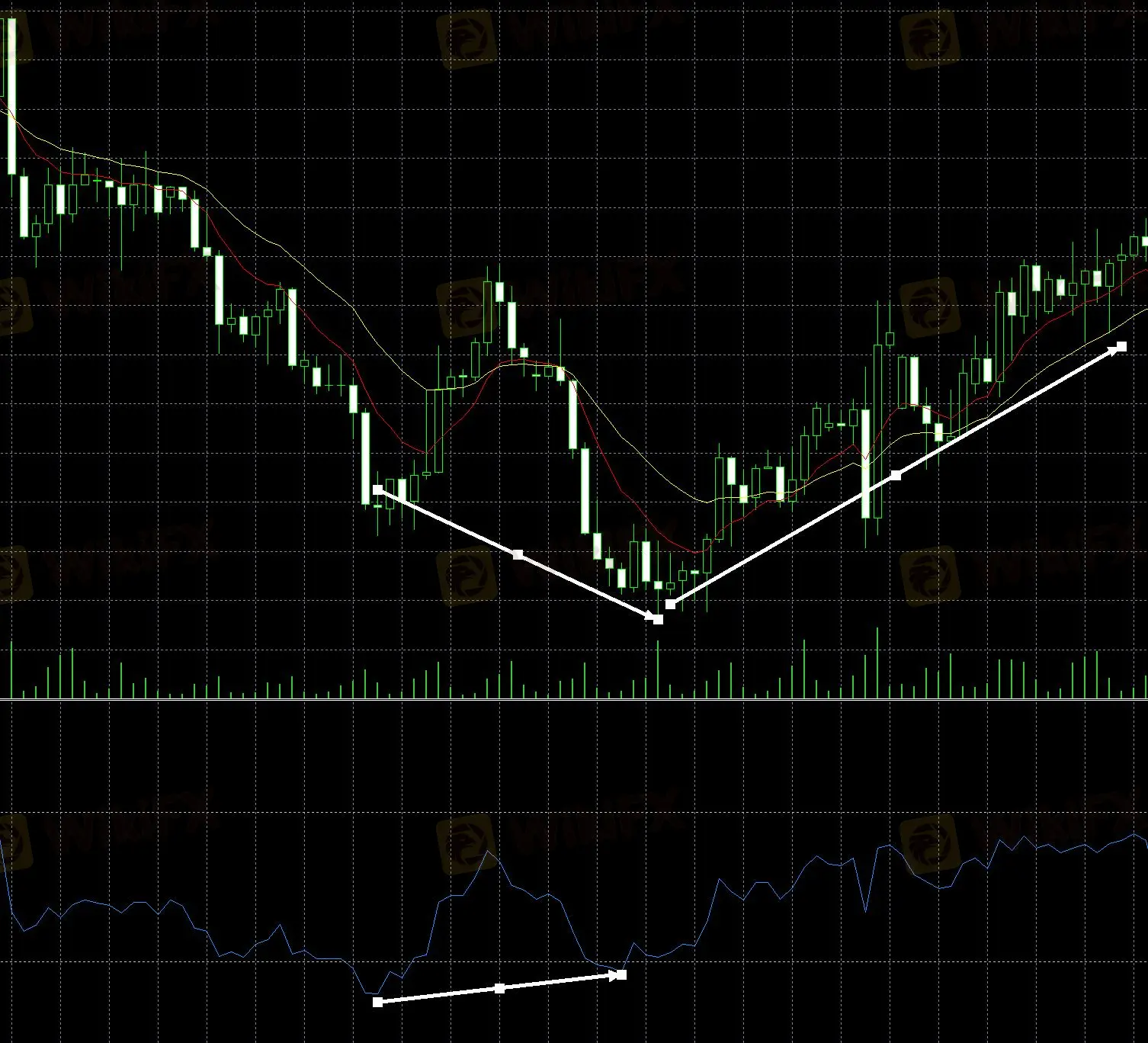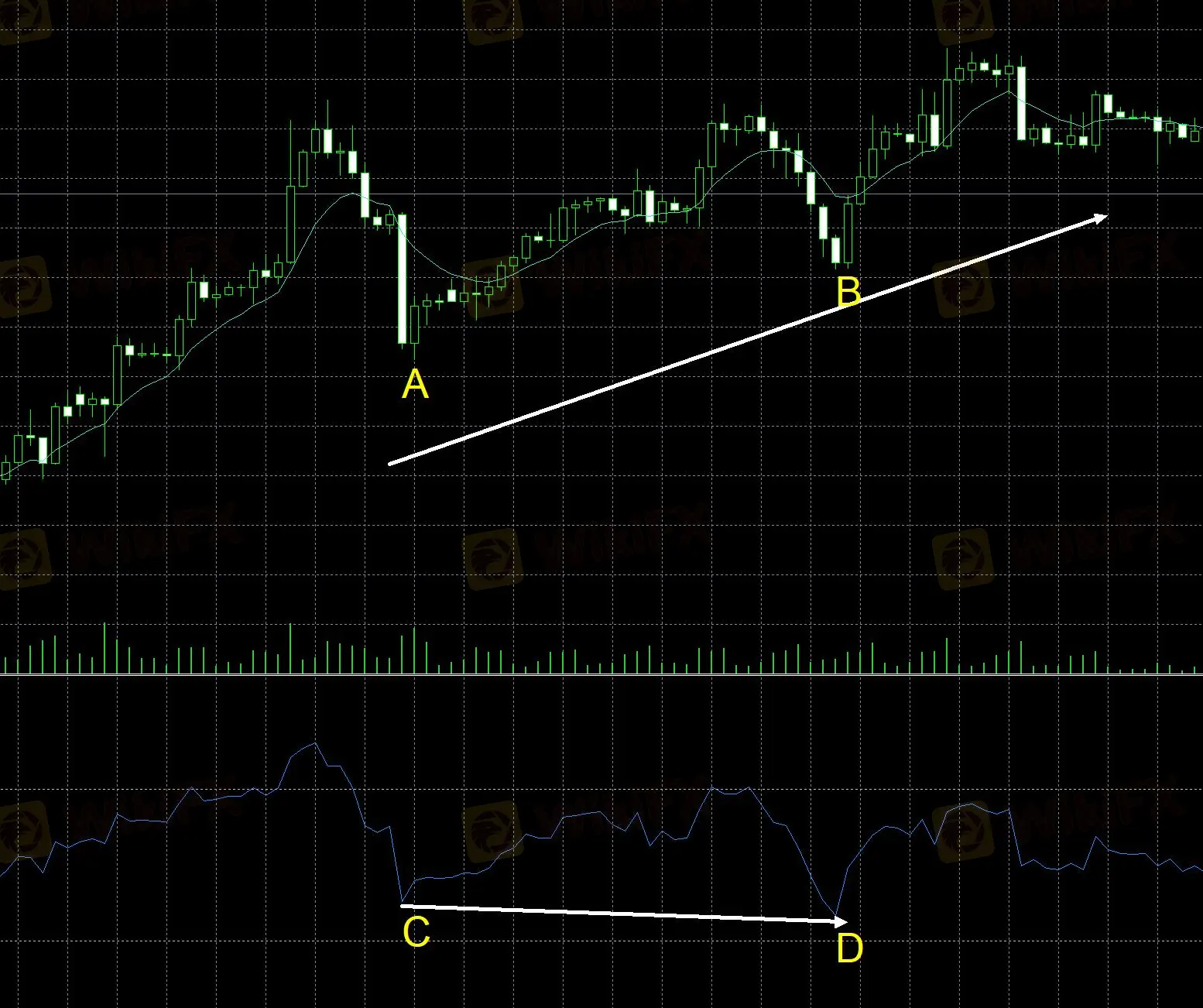简体中文
繁體中文
English
Pусский
日本語
ภาษาไทย
Tiếng Việt
Bahasa Indonesia
Español
हिन्दी
Filippiiniläinen
Français
Deutsch
Português
Türkçe
한국어
العربية
How Does RSI Divergence Work in Trading: Top Cases
Abstract:The Relative Strength Index, short for RSI, is primarily used to evaluate the strength of bullish and bearish forces and measure the momentum of price changes in terms of speed and magnitude.
What Is the Relative Strength Index(RSI)?
The Relative Strength Index, short for RSI, is primarily used to evaluate the strength of bullish and bearish forces and measure the momentum of price changes in terms of speed and magnitude.
RSI ranges from 0 to 100. When the RSI value is greater than 70, the market is considered to be in an overbought condition, indicating a higher probability of a future market decline. When the RSI value is less than 30, the market is considered to be in an oversold condition, indicating a higher probability of a future market rise. RSI can also be used in conjunction with other technical indicators for analysis and is one of the mainstream technical analysis tools in the market.
What Is Divergence?
Typically, divergence refers to the phenomenon where the price and technical indicators move in opposite directions, suggesting that the current price trend may be gradually weakening. This is an important reference for traders for them to make trading decisions.
Most technical indicators exhibit divergence, such as Stochastic Oscillator Divergence, MACD Divergence, and RSI Divergence, andthe most valuable divergences, are top divergence and bottom divergence.
Top divergencemeans when prices make new highs without technical indicators reaching new highs, indicating that prices may top and fall in the future. Bottom divergencemeans when prices make new lows without technical indicators reaching new lows, indicating that the downward price trend may shift in the future.
Typical Types of RSI Divergence
The Relative Strength Index (RSI) diverges when price action goes counter to the RSI's trend. Another way of looking at it is that a chart could show a shift in momentum before the price changes.
In RSI, there are typically four different types of divergences. And traders can employ these RSI Divergences to inform their judgements.
- Regular Bullish Divergence
- Regular Bearish Divergence
- Hidden Bullish Divergence
- Hidden Bearish Divergence.
Regular Bullish Divergence
This occurs when the price is in a downtrend and continues to make new lows, but the RSI forms higher lows. This bullish divergence typically signals a potential reversal of the short-term trend, suggesting that the downward trend may end and the price could start to rise in the future.The chart below shows the EUR/USD exchange rate candlestick chart. We can see that while the price is declining, the RSI value is rising. This indicates a Regular Bullish Divergence, suggesting that the price may increase in the future.

Regular Bearish Divergence
This occurs when the price is in an uptrend and continues to make new highs, but the RSI forms lower highs. This bearish divergence typically indicates that the short-term uptrend may be coming to an end, suggesting that a peak may be forming and a price pullback could occur in the future.The chart below shows the EUR/USD exchange rate candlestick chart. We can see that while the price is rising, the RSI value is declining. This indicates a Regular Bearish Divergence.

Hidden Bullish Divergence
This occurs during an uptrend when the price makes higher lows, but the RSI forms lower lows. This type of divergence usually appears within an uptrend and suggests that the bullish trend is likely to continue, with a low probability of a reversal. As shown in the chart below, the price at point B is higher than the price at point A, but the corresponding RSI value at D is lower than at C. This phenomenon is known as Hidden Bullish Divergence.

Hidden Bearish Divergence
This occurs during a downtrend when the price makes lower highs, but the RSI forms higher highs. This type of divergence usually appears within a downtrend and suggests that the bearish trend is likely to continue. Traders considering long positions should be cautious, as the downtrend may persist.As shown in the chart below, the price at point B is lower than the price at point A, but the corresponding RSI value at D is higher than at C. This phenomenon is known as Hidden Bearish Divergence.

How to Use the RSI Divergence Indicator for Trading
The RSI (Relative Strength Index) is a momentum indicator, which allows tradersto determine whether the market is in an overbought or oversold condition in the short term. At a basic level, RSI divergence is an effective short-term technical indicator. Now, let's explore how to use it for efficient trading.
Using RSI Divergence to Identify Trend Reversals
The chart below shows the EUR/USD exchange rate candlestick chart. We can see that the price at point B is higher than at point A, but the corresponding RSI value at point D is lower than at point C. This situation indicates a regular bearish divergence in RSI, suggesting that the short-term upward trend might reverse and the likelihood of a price decline in the future is high. As shown in the chart, 1.086 is a resistance level. After the bearish divergence structure appeared, the exchange rate rebounded to position 1 (the resistance level). At this point, we can enter a short trade, and as we anticipated, the exchange rate started to decline.

The chart below shows the EUR/USD exchange rate candlestick chart. As shown, the price at point B is lower than at point A, but the corresponding RSI value at point D is higher than at point C. This situation indicates a regular bullish divergence in RSI. The short-term decline may have reached its bottom, and the price is likely to rise in the future. We can consider entering a long trade at position 1.

Combine RSI Divergence with Other Indicators to Trade
The RSI divergence indicator also has its limitations. The occurrence of RSI divergence does not necessarily mean that future market conditions will change. Traders should use other technical indicators in conjunction with RSI divergence to make more informed decisions.
Combining RSI Divergence with Moving Averages
The chart below shows the GBP/USD exchange rate. We can see that the price at point B is lower than point A, but the corresponding RSI value D is higher than value C, indicating an RSI bullish divergence. The red lines represent short-term resistance levels, the red curve represents the short-term moving average, and the yellow curve represents the long-term moving average. When the short-term moving average crosses above the long-term moving average, it is highly likely that the market will rise in the future. Combining this with the previously noted RSI bullish divergence, we expect the price to potentially increase. After the price breaks through the red resistance level, attempting to go long at position 1 will likely have a high success rate.

Combining RSI Divergence with Bollinger Bands
The chart below shows the GBP/USD exchange rate. At point B, the exchange rate is significantly lower than at point A, but the RSI value at B is higher than at A, indicating an RSI bullish divergence. At this time, the price at point B is at the lower Bollinger Band, providing strong price support. After the price rebounds and stabilizes at the middle Bollinger Band, a long trade can be considered.

How to Find RSI Divergence in MT5
MetaTrader (MT5), the popular forex trading platform, offers huge advantages for RSI divergence traders, compared with MetaTrader 4 (MT4). As a newer platform, MT5 boasts more features and a wider selection of third-party indicators, specifically designed to pinpoint these signals. Besides, the enhanced stability of MT5 guarantees smooth execution when capitalizing on divergence opportunities.
Here is the simple and easy reference to show how to find RSI divergence:
Step 1: Find the RSI indicator in the navigation bar and set the RSI indicator period. The commonly used RSI period is 14. The specific operation is as shown below.


Step 2: Identify the lowest and second-lowest price points over a period, such as point B and point A. Compare the corresponding RSI values for these points. If the RSI values show an opposite relationship to the price (higher RSI at a lower price), this indicates RSI divergence, suggesting a potential reversal of the short-term downtrend.

Conclusion
Overall, learn the RSI divergence indicator if you're a beginner trader. It is one of the most popular technical indicators out there. Though relative strength index (RSI) divergence is a solid entry point, remember that it's hard to be consistently profitable when you use only one technical signal. Another requirement is a never-ending quest for knowledge regarding technical indications. Moreover, risk management tactics must be put into place prior to each trade entry. After all, your success in the long run depends on this.
FAQ
Can RSI Divergence Ensure Profit?
No, technical analysis or indicator can guarantee 100% profit for investors. Traders need to find indicators that suit their style and develop a mature trading system to achieve long-term profitability.
Is the RSI divergence indicator accurate?
The accuracy of RSI divergence can vary with different time frames. While RSI divergence can occur in any time frame, many traders find that divergences in longer time frames tend to provide more reliable information.
Is RSI Divergence Suitable for Day Traders?
Day traders need indicators that are sensitive to short-term price changes. Short-term RSI is more responsive to price fluctuations. It is a suitable choice for day traders who want to use RSI divergence to guide their trades.
Disclaimer:
The views in this article only represent the author's personal views, and do not constitute investment advice on this platform. This platform does not guarantee the accuracy, completeness and timeliness of the information in the article, and will not be liable for any loss caused by the use of or reliance on the information in the article.
Read more

Top Tips to Avoid Forex Margin Calls and Protect Your Capital
While technical indicators or chart patterns often capture the attention of forex traders, especially new ones, aspects such as margin requirements, equity, used margin, free margin, and margin levels are often overlooked. So, if you have received a margin call from your forex broker and are wondering how to deal with it, you probably do not know the concept of a forex margin call - what triggers it and how to avoid it. Being unaware of this concept can make you lose your hard-earned capital. In this article, we will provide you with all the information you need to know. Keep reading!

Top 5 Forex Trading Mistakes to Avoid
Posting impressive forex trading profits requires attention to detail and impeccable discipline. Jumping straight into trading without meaningful preparation can dent your hard-earned capital. Despite being a profitable investment avenue, some traders face mountains of losses owing to common forex trading mistakes they commit. In this article, we have discussed the forex mistakes to avoid. Read on and implement these lessons when trading.

Scalping vs Swing Trading: Which Forex Strategy Suits You Better?
Confused about which to choose between scalping and swing trading? The basic difference between the two is this - While scalping involves quick trades meant to earn small profits, usually within minutes, swing trading focuses on larger price movements over a few days or even weeks. Keeping this in mind, we have shared the definition of scalping and swing trading, their pros and cons, and other critical insights. Keep reading to learn about which is better - forex scalping vs swing trading.

What is NFP in Forex? An Insightful Guide for Traders
The Non-farm Payroll (NFP) report may be for the US. However, the report, which is issued every month, impacts the forex market globally. The monthly report estimates the number of jobs gained in the US in the previous month. The job numbers stated on this report exclude those of farms, private households, and non-profit organizations. Usually released on the first Friday of the month, the report also includes the US unemployment rate, average hourly earnings, and participation rate. In this article, we have answered the question - what is NFP in forex - and shared other pertinent details. Read on!
WikiFX Broker
Latest News
Stonefort Securities Review: A Fair Look at Safety, Rules, and What Traders Say
Trump asks for meat packer probe over beef prices
Voices of the Golden Insight Award Jury | Tim Waterer, Chief Market Analyst of KCM Trade
Prop Firm Scams: When ‘Getting Funded’ Costs You Everything
PINAKINE Broker Review: A Complete Look at Its Services and Risks
One-Click Access to Broker Official Group Chats & Exclusive VPS Benefits
Consumer sentiment nears lowest level ever as worries build over shutdown
Uniglobe Markets MT4 Review: A Complete Look at Features, Costs, and Important Safety Issues
Is PINAKINE Broker Safe or a Scam? A 2025 Complete Review
Easy Money Doesn't Exist! High-Return Promise Turned into an RM44,000 Scam
Currency Calculator




